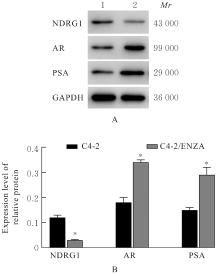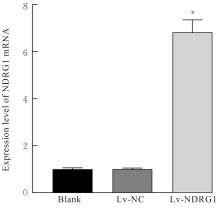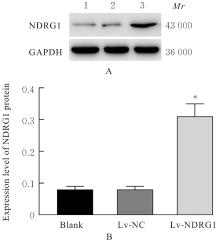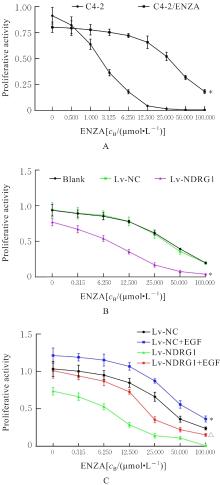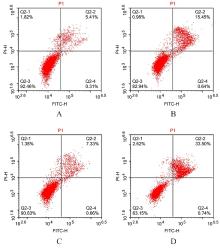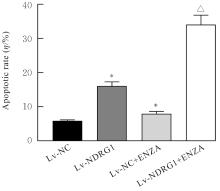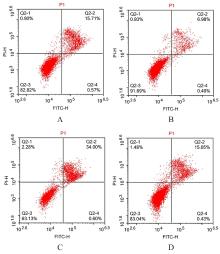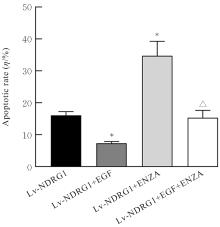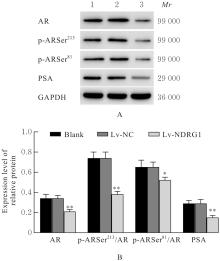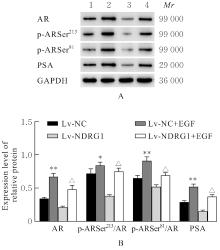| 1 |
SEKHOACHA M, RIET K, MOTLOUNG P, et al. Prostate cancer review: genetics, diagnosis, treatment options, and alternative approaches[J]. Molecules, 2022, 27(17): 5730.
|
| 2 |
SUNG H, FERLAY J, SIEGEL R L, et al. Global cancer statistics 2020: GLOBOCAN estimates of incidence and mortality worldwide for 36 cancers in 185 countries[J]. CA Cancer J Clin, 2021, 71(3): 209-249.
|
| 3 |
LIU J Z, DONG L, ZHU Y J, et al. Prostate cancer treatment - China’s perspective[J]. Cancer Lett, 2022, 550: 215927.
|
| 4 |
RITCH C, COOKSON M. Recent trends in the management of advanced prostate cancer[J]. F1000Res, 2018, 7.DOI:10.12688/f1000vesearch.15382.1 .
doi: 10.12688/f1000vesearch.15382.1
|
| 5 |
HE Y X, SHEN H, JI Y Z, et al. N-myc downstream regulated gene 1 inhibition of tumor progression in Caco2 cells[J]. World J Gastrointest Oncol, 2022, 14(12): 2313-2328.
|
| 6 |
VILLODRE E S, HU X D, ECKHARDT B L, et al. NDRG1 in aggressive breast cancer progression and brain metastasis[J]. J Natl Cancer Inst, 2022, 114(4): 579-591.
|
| 7 |
MAO M S, JIA Y L, CHEN Y X, et al. HJURP regulates cell proliferation and chemo-resistance via YAP1/NDRG1 transcriptional axis in triple-negative breast cancer[J]. Cell Death Dis, 2022, 13(4): 396.
|
| 8 |
LIM S C, GELETA B, MALEKI S, et al. The metastasis suppressor NDRG1 directly regulates androgen receptor signaling in prostate cancer[J]. J Biol Chem, 2021, 297(6): 101414.
|
| 9 |
郭晓波, 李 岗, 赵宇峰, 等. 长非编码RNA linc00641通过调节miR-362-5p/NDRG1逆转前列腺癌细胞多西他赛耐药的研究[J]. 沈阳药科大学学报, 2022, 39(6): 703-708.
|
| 10 |
杨嘉昕, 夏 僮, 周驷杰, 等. 双氢青蒿素对前列腺癌PC-3 细胞自噬的诱导作用及其机制[J]. 解放军医学杂志, 2023, 48(6): 676-685.
|
| 11 |
李 芳, 蒋妮谚含, 柳文洁, 等. 肿瘤耐药发生机制的研究进展[J]. 肿瘤药学, 2018, 8(3): 307-312.
|
| 12 |
NGUYEN D T, YANG W, RENGANATHAN A, et al. Acetylated HOXB13 regulated super enhancer genes define therapeutic vulnerabilities of castration-resistant prostate cancer[J]. Clin Cancer Res, 2022, 28(18): 4131-4145.
|
| 13 |
DUTTA S, POLAVARAM N S, ISLAM R, et al. Neuropilin-2 regulates androgen-receptor transcriptional activity in advanced prostate cancer[J]. Oncogene, 2022, 41(30): 3747-3760.
|
| 14 |
CHEN X, YANG G, LIU M, et al. Lycopene enhances the sensitivity of castration-resistant prostate cancer to enzalutamide through the AKT/EZH2/androgen receptor signaling pathway[J]. Biochem Biophys Res Commun, 2022, 613: 53-60.
|
| 15 |
DU Z B, CHEN X B, ZHU P Y, et al. SOX8 knockdown overcomes enzalutamide resistance in castration-resistant prostate cancer by inhibiting the Notch signaling pathway[J]. Biomed Res Int, 2022, 2022: 9235837.
|
| 16 |
王 蓓, 代聪伟, 李 娜, 等. 上调NDRG1基因对人卵巢癌OVCAR3细胞周期和凋亡的影响[J]. 中国老年学杂志, 2021, 41(14): 3045-3049.
|
| 17 |
崔 喆, 商 震, 谷 乐, 等. 上调NDRG1表达降低奥沙利铂耐药结肠癌细胞的存活率[J]. 实用药物与临床, 2020, 23(4): 289-293.
|
| 18 |
YANG G, HUANG L, JIA H T, et al. NDRG1 enhances the sensitivity of cetuximab by modulating EGFR trafficking in colorectal cancer[J]. Oncogene, 2021, 40(41): 5993-6006.
|
| 19 |
ANESTIS A, ZOI I, PAPAVASSILIOU A G, et al. Androgen receptor in breast cancer-clinical and preclinical research insights[J]. Molecules, 2020, 25(2): 358.
|
| 20 |
PLATA BELLO A, TAMAYO JOVER M A, GUTIERREZ NICOLAS F, et al. Biomarkers for characterization and therapeutic orientation in castration-resistant prostate cancer[J]. Arch Esp Urol, 2022, 75(2): 195-202.
|
| 21 |
KHAN A, MAO Y S, TAHREEM S, et al. Structural and molecular insights into the mechanism of resistance to enzalutamide by the clinical mutants in androgen receptor (AR) in castration-resistant prostate cancer (CRPC) patients[J]. Int J Biol Macromol, 2022, 218: 856-865.
|
| 22 |
孙 红, 侯佳林, 蔡加琴, 等. SUMO E3连接酶介导雄激素受体的转录促进乳腺癌他莫昔芬耐药[J]. 中国临床药理学与治疗学, 2021, 26(3): 285-291.
|
| 23 |
GHILDIYAL R, SAWANT M, RENGANATHAN A, et al. Loss of long noncoding RNA NXTAR in prostate cancer augments androgen receptor expression and enzalutamide resistance[J]. Cancer Res, 2022, 82(1): 155-168.
|
| 24 |
BONACCORSI L, MURATORI M, CARLONI V, et al. The androgen receptor associates with the epidermal growth factor receptor in androgen-sensitive prostate cancer cells[J]. Steroids, 2004, 69(8/9): 549-552.
|
| 25 |
SHORNING B Y, DASS M S, SMALLEY M J, et al. The PI3K-AKT-mTOR pathway and prostate cancer: At the crossroads of AR, MAPK, and WNT signaling[J]. Int J Mol Sci, 2020, 21(12): 4507.
|
| 26 |
HSIEH T F, CHEN C C, MA W L, et al. Epidermal growth factor enhances androgen receptor-mediated bladder cancer progression and invasion via potentiation of AR transactivation[J]. Oncol Rep, 2013, 30(6): 2917-2922.
|
 ),Xianxun JIANG1
),Xianxun JIANG1
